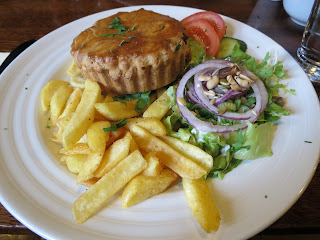 |
| Part of the View from Charles Fort |
The major part of my trip to Kinsale was Charles Fort. It was about a 45 minute walk from Kinsale to the fort, although this, of course, involved lots of stopping and taking photos. I wasn't really sure what to expect from the fort. I knew that it was star-shaped and large, but that was about it. The walk there was gorgeous, even if the last bit was a very steep hill. The views were beyond worth it.
 |
| Some of the Buildings |
When I finally reached the fort, I was struck by its beauty. While it's in a certain state of disrepair, it was very striking. I was also, once again, struck by how amazing the Office of Public Works is. The fort is owned by them and because it's owned by the government I only had to pay two euro to get in. This also included a little museum they had in the fort as well as an information session.
 |
| Some of the Newer Buildings |
 |
| Me in One of the Fort Nooks |
I spent about an hour just wandering the grounds and taking tons of photos. Not only did I find the structures beautiful, but Charles Fort had an amazing view. After I wandered for a bit I was heading out toward the exit when I saw the tour guide standing alone on the mosaic plan for the fort, which I knew is where the information session was being held. I quickly walked up the hill so that I could make it before he gave up hope and just left.
 |
| The Mosaic Schematic |
The fort has a very interesting history. The star shape was meant to give better angles for the defenders to attack the invaders. The walls were also between 15 and 30 meters thick, however, the fort remained the most vulnerable from the land side. I was surprised to learn that it was used as a fort even in modern times, it was used as a training camp in World War II. It was only attacked once, in 1690, and it actually fell to the invaders. During Ireland's struggle for independence however, it was set on fire. This is one of the reasons why all of the buildings are in such disrepair, the other being that after the burning people would come and take stone from the buildings for their houses. I found it rather amusing that in the 1960s it actually became a kind of commune for hippies.
 |
| More of the Fort Buildings |
While the guide was giving the lecture I checked out the mosaic schematic and noticed that there were married quarters as well as a liquor store so I asked him about them. He said that for a while men were expected to be married to the army and that it wasn't until the 19th century that men were allowed to marry, but only 6% were. After considering that most of those getting married were officers, probably only about 2% of soldiers were getting married. While there wasn't a school on the map, the guide said there was likely some accommodation for the small number of children within the fort. He said that the liquor store must have been a later installation as originally there was only weak beer served in the fort, and even that wasn't a very old practice. Although he said it's the reason why some Irish people say "small beer," much like we'd use the phrase "small potatoes."






















































